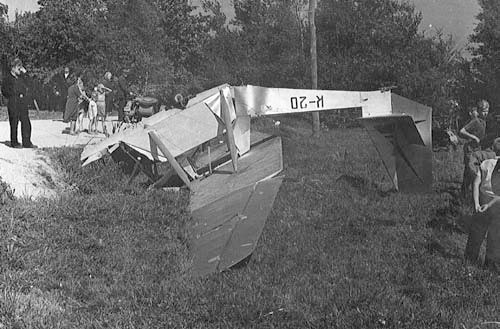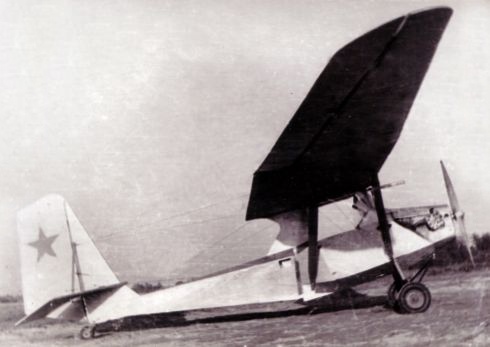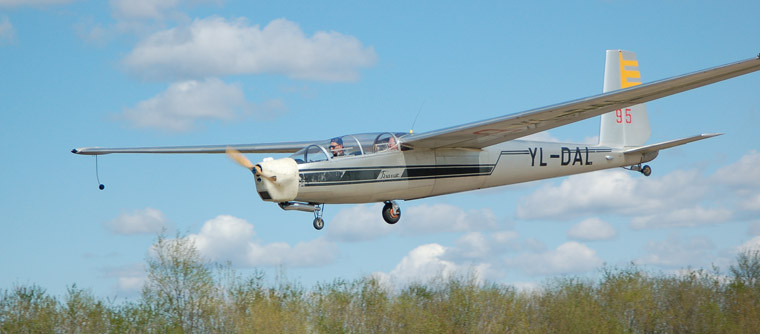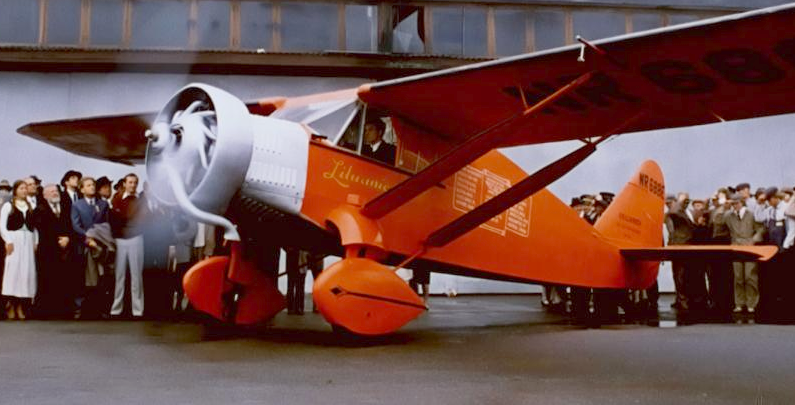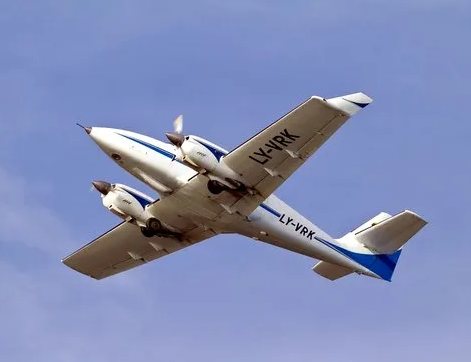- Joined
- 25 June 2009
- Messages
- 14,735
- Reaction score
- 6,077
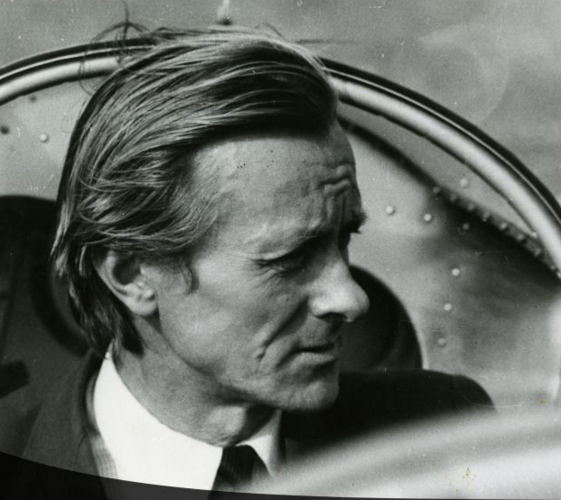 Vladas Kensgaila was born on September 23, 1933 in the village Bikavėnai, in the Šilutė district of Lithuania. Vladas was very proud that this was also the year that his heroes Stephen Darius and Stasys Girėnas flew across the Atlantic (a landmark which would have a strong impact on his career as we'll see later on). First class pilot, master of aviation sports, he developed and built a series of flying machines that hold an essential place in the history of Baltic aviation. In Soviet times, he walked on a razor's edge, at the risk of losing his favorite job — aviation —, even of being deported to Siberia. Looking back at his life in retrospect, it is obvious that he never lost heart, but instead carried on living with courage, ingenuity and adventure. A versatile character, he not only flew, but also constructed, danced, sang, drew. After being arrested by the KGB for underground activities, he could no longer work as a manager, leave from his place of residence without asking, and so forth; and yet he did it all defiantly: he left without telling anyone, spoke to his supervisers as equals, and made friends that were not palatable to the Soviet regime. His cagers were annoyed by this, so they "tightened his screws" even more, but Vlad never gave up and found a way out of the most difficult situations.
Vladas Kensgaila was born on September 23, 1933 in the village Bikavėnai, in the Šilutė district of Lithuania. Vladas was very proud that this was also the year that his heroes Stephen Darius and Stasys Girėnas flew across the Atlantic (a landmark which would have a strong impact on his career as we'll see later on). First class pilot, master of aviation sports, he developed and built a series of flying machines that hold an essential place in the history of Baltic aviation. In Soviet times, he walked on a razor's edge, at the risk of losing his favorite job — aviation —, even of being deported to Siberia. Looking back at his life in retrospect, it is obvious that he never lost heart, but instead carried on living with courage, ingenuity and adventure. A versatile character, he not only flew, but also constructed, danced, sang, drew. After being arrested by the KGB for underground activities, he could no longer work as a manager, leave from his place of residence without asking, and so forth; and yet he did it all defiantly: he left without telling anyone, spoke to his supervisers as equals, and made friends that were not palatable to the Soviet regime. His cagers were annoyed by this, so they "tightened his screws" even more, but Vlad never gave up and found a way out of the most difficult situations.Let's take a look at his career chronologically, with emphasis on his aircraft:
- 1952 — Kensgaila starts studying at Žemaičiai Naumiestis secondary school.
- In the same year, he founds an underground anti-communist organization with like-minded people.
After a couple of years, though, it is discovered, and in 1954 Kansgaila is arrested and sent to Vilnius Lukiškii prison. - After Stalin's death, Kensgaila is amnestied as the repression subsides. Falsifying the facts of his biography, he manages to finish high school, subsequently working at Šilute's schoolhouse, library and culture house.
- 1956 — Kensgaila co-founds the Šilute aviation sports club, which he will preside over from 1960 to 1973 (some sources give 1957-1974).
-
 1958 — He builds the VK-2 single-seater training glider.
1958 — He builds the VK-2 single-seater training glider. - 1959 — He builds the VK-3 two-seater training glider, which makes carries the very first glider air mail, but is lost in a crash because of a truck blocking the runway.
- 1961 — Leading a group of amateur aircraft designers, Kensgaila sets out to design a microplane, the VK-4 "Žuvėdra" ("seagull"), a single-seat, braced, high-wing aircraft of wooden construction with plywood and canvas sheathing. The VK-4 uses some components of the serial Antonov A-2 glider as a basis, and a 22 hp (16.2 kW) M‑72 motorcycle engine for power. For optimal operation of the engine with a 1.7 m-diameter propeller, it is necessary to install a gearbox on the engine, which reduces the maximum speed to 2700 rpm. The VK-4 has a reinforced tail boom of triangular cross-section with vertical and horizontal tails, reinforced with cable braces and struts. The aircraft's
 landing gear is pyramidal, made of steel pipes. The wheels were snatched from a Vyatka scooter, and shock absorbers are fitted. The tail support is wheeled, with a one-piece wheel made of soft rubber. A gas tank with a capacity of 20 liters is installed in the center section. Fuel is supplied to the engine by gravity. The cabin is enclosed, with a door on the right side. The instrument panel contains the main flight instruments and a tachometer. The plane is created in six months, being built in winter and spring and first flown in the summer of 1961. It is then flown extensively, with good
landing gear is pyramidal, made of steel pipes. The wheels were snatched from a Vyatka scooter, and shock absorbers are fitted. The tail support is wheeled, with a one-piece wheel made of soft rubber. A gas tank with a capacity of 20 liters is installed in the center section. Fuel is supplied to the engine by gravity. The cabin is enclosed, with a door on the right side. The instrument panel contains the main flight instruments and a tachometer. The plane is created in six months, being built in winter and spring and first flown in the summer of 1961. It is then flown extensively, with good
 stability and controllability and a fairly high vertical speed for low-power aircraft (2.5 m/s).
stability and controllability and a fairly high vertical speed for low-power aircraft (2.5 m/s). - 1963 — After completing aviation courses, Kensgaila is certified as a pilot-instructor.
- 1968° — Kensgaila graduates from Kaluga aviation school in Russia, obtaining the title of pilot-engineer. (° or 1969, depending on sources)
- 1974 — Kensgaila gets a job at the Prienai Aviation Factory (LAK) as a test pilot and constructor, and from 1974 to 1977 works on experimental aircraft there, testing gliders.
- 1975 — Kensgaila builds the LAK-6 (also designated by him as the VK-5), a motorized Blanik glider. He adapts a special 65-horsepower engine to the "Blanik" glider, which can now reach an altitude of 1,000 m in 5 minutes with it. Contrary to other powered Blaniks, the engine is not mounted on the back in a pusher configuration, but fitted in the nose in tractor mode. After shutting down the engine and stopping the propeller, the new flying machine became a glider again.
- 1981 — He moves to Panevėžys, and works as an engineer-pilot at the Panevėžys Aviation Technical Sports Club until 1988.
- 1982-83 — Kensgaila builds his VK-6, a flying replica of the historical airplane "Lituanica" of Steponas Darius and Stasios Girėnas (a Bellanca CH-300 Peacemaker). The replica is used in the filming of the feature film Skrydžio per Atlantą (Flight over the Atlantic), directed by Raimondas Vabalas (1983).
- 1986 — Kensgaila builds the SSAKTB SL-2P (or VK-7), a "Twin Blanik" glider flying laboratory used to study laminar flow airfoils, and consisting of two Blanik gliders coupled with a wing and tailplane plug for a twin fuselage configuration. Two people sit in the left fuselage: a pilot and an observer/recorder.
- 1989 — Kensgaila builds the VK-8 "Aušra" agricultural airplane. The Aušra is recognized as the best example of new technology in the Soviet Union for its unique technical data, and enters the Guinness Book of Records as the most efficient and economical airplane of its type.
- In order to demonstrate Lithuania's independence, flies with his son Darius in 1991 aboard the Aušra plane to an exhibition of new aviation works in Stockholm. On the way back, Soviet fighter jets force them to land at a military base to interrogate them, and the plane is recovered only after the August putsch in Russia.
- 1992 — Kensgaila becomes a member of the International Experimental Sports Aviation Association.
- 1993 — Celebrating the 60th anniversary of the flight of S. Darius and S. Girėnas, Kensgaila built the "Lituanica 1993" plane, a second flying replica of the eponymous Bellanca CH-300, but only a half-scale one. Together with Edmund Jasiūnas, a Lithuanian from the United States of America, he made the flight Kaunas-Soldinas-Kaunas, thus symbolically ending the lengendary pilots' journey. Kensgaila was honored with the Medal of S. Darius and S. Girėnas that same year for his achievement.
- 2001— Kensgaila becomes a Member of the Panevėžys Municipal Council (a position he occupies until 2011).
 2003 — Celebrating the 70th anniversary of the flight of "Lituanica", the replica aircraft flies around Lithuania. That same year, the Lithuanian Post issues a postal envelope with the portrait of V. Kensgaila, and he is made an honorary citizen of the city of Panevėžys. The replica now hangs at the Vilnius airport.
2003 — Celebrating the 70th anniversary of the flight of "Lituanica", the replica aircraft flies around Lithuania. That same year, the Lithuanian Post issues a postal envelope with the portrait of V. Kensgaila, and he is made an honorary citizen of the city of Panevėžys. The replica now hangs at the Vilnius airport.- 2009-10 — Kensgaila builds his final design, the VK-9 twin-engine eight-seater commercial aircraft.
- 2010 — A third replica of the legendary airplane "Lituanica" is built by two Lithuanians based in Great Britain under the guidance of V. Kensgaila in the Panevėžys Aero Club for almost 3 months. This time it's only an exact 1:4 scaled-down replica of the plane, set to be exhibited at the Expo 2010 world exhibition in Shanghai. Its wingspan is 4 m, its body is about 2 m, and its weight is about 40 kg. The replica is officially presented at the "Ozas" shopping and entertainment center, before leaving for Expo 2010, and on July 15, it is hung as a symbol of Lithuanian unity to commemorate the 77th anniversary of the historic flight and the 600th anniversary of the Battle of Žalgiris, and to represent the country in the Lithuanian Pavilion.
Vladas Kensgaila may not be known outside of Lithuania, but he managed to make remarkable aviation achievements despite the limited leeway and resources of the Soviet era. Later on, he made an invaluable contribution to the popularization of aviation history in his home country. All of Kensgaila's aircraft were well evaluated by specialists. Kensgaila died on February 21, 2024, at the age of 90.
Research by Stéphane Beaumort
Research by Stéphane Beaumort
Sources include:
- Argentinos Lietuvių Balsas, April 1, 1976
- "Įspūdingas ir sparnuotas Vlado Kensgailos gyvenimas", in Kultūros barai, September & October 2012
Last edited:

